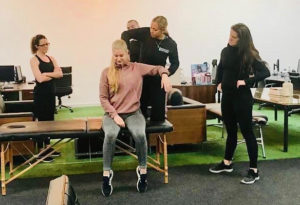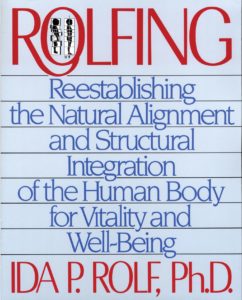Strength Sensei Bookshelf

Rolfing by Ida P. Rolf, Ph.D.
The classic textbook that created a paradigm shift in how we treat soft tissue
In the late 90s, Charles R. Poliquin met Dr. Mike Leahy and had his first soft treatment called Active Release Techniques Treatment ® (ART). The Strength Sensei experienced dramatic and immediate increases in shoulder mobility. He was hooked, and set about to learn ART to help his clients. But no discussion of soft tissue treatments would be complete without giving credit to Ida P. Rolf, Ph.D.
Dr. Rolf’s classic textbook Rolfing was published in 1977 and comes with this bold subtitle: “Reestablishing the Natural Alignment and Structural Integration of the Human Body for Vitality and Well-Being.” As with ART, one of the primary benefits of Rolfing is to treat alterations in tissue and tension. Besides restoring his range of motion in his shoulders, the Strength Sensei noticed a remarkable increase in strength.
After his first session, Strength Sensei found that his bench press max increased by 35 pounds in a single day! And as an ART practitioner, he witnessed dramatic increases in other lifts. For example, he said that after a single five-minute treatment on the biceps, his clients often increased their curling poundages by 15 percent!
The takeaway is that if you’re a strength coach and want to get the most out of your athletes, you should be aware of the soft tissue treatments available and be able to refer your clients to experienced practitioners. Or, in the case of Strength Sensei instructors such as Heather Pearson who became an ART practitioner and a Strength Sensei instructor (and who is shown in the lead photo), learn how to administer them yourself.
To be clear, Rolfing is not a book about ART. (To learn more about ART, check out Release Your Pain by Brian J. Abelson and others). It’s also not a book that will teach you how to administer Rolfing techniques. Rather, Rolfing explains a theory of posture and human movement and how to treat it when the body is in pain and doesn’t work the way it should.
 Rolfing is considered a pioneering work in the treatment of soft tissues.
Rolfing is considered a pioneering work in the treatment of soft tissues.
Despite its complex subject matter and being 304 pages, Rolfing is surprisingly readable. Dr. Rolf wrote this book in the second person (“you”) and the style could be considered conversational. And to help the reader better understand her material, she often uses many analogies. For example, she explains fascia by comparing it to how orange wedges stay together and how a sweater distorts when you pull on one part of it. Further, Rolfing is well-illustrated with, collectively, over 600 photos and drawings.
One of the key ideas Dr. Rolf champions is that of “structural integration.” As it relates to weight training, Dr. Rolf discusses how exercise, especially to the point of overtraining, can reduce the elasticity of the muscles and cause them to be chronically shortened. It follows that those who lift weights should take a “proactive” rather than a “reactive” approach to soft tissue treatments. That is, don’t wait till you get injured before seeking help. Work with a soft tissue practitioner to determine potential imbalances that make you more susceptible to serious injuries; or, for athletes, issues that can affect athletic performance.
For anyone interested in pursuing a career as a massage therapist or any of the numerous other hands-on healing professions, it would be a worthwhile investment to purchase a copy of Rolfing by Ida P. Rolf. (TSS)
[Rolfing by Ida P. Rolf, Ph.D. is available in paperback and a Kindle version through Amazon.com.]
